Inside The New York Botanical Garden
Posted in Shop/Book Reviews on November 24 2009, by Plant Talk
 |
Stephen Sinon is Head of Information Services and Archives in The New York Botanical Garden’s LuEsther T. Mertz Library. |
 The Grand Concourse, stretching over four-and-a-half miles in the Bronx, is one of New York City’s lesser known architectural delights. Now its political and social history is the subject of a new book, Boulevard of Dreams: Heady Times, Heartbreak, and Hope along the Grand Concourse in the Bronx, by New York Times City Desk editor Constance Rosenblum.
The Grand Concourse, stretching over four-and-a-half miles in the Bronx, is one of New York City’s lesser known architectural delights. Now its political and social history is the subject of a new book, Boulevard of Dreams: Heady Times, Heartbreak, and Hope along the Grand Concourse in the Bronx, by New York Times City Desk editor Constance Rosenblum.
The thoroughfare, modeled after Paris’s Champs-Élysées, was completed in 1909 and saw the arrival of many Art Deco structures housing upwardly mobile Jews in the first five decades of the 20th century, followed by waves of Irish and Italian immigrants.
While Rosenblum explores various aspects of Jewish communal life near the boulevard, she also dissects the rivalry between the affluent West Bronx and the working-class East Bronx, and the racial tensions that led to white suburban flight and the decline and neglect of the area. The first major book to document the rise, fall, and current revival of this century-old Bronx landmark is a must-read for those interested in the cultural history of New York City, urban history, Jewish-American life, and yes, even baseball and the Lindbergh baby kidnapping.
Read More
Posted in Gardening Tips on November 23 2009, by Sonia Uyterhoeven
 |
Sonia Uyterhoeven is Gardener for Public Education. |
I think it is worth reflecting further on the effects of the cool, rainy weather we had this season—not to reminisce but rather to attain a deeper understanding of the practice of gardening.
Something came along this year that caught people by surprise. Late blight (Phytophthora infestans) swept through the region like a hurricane and caught everyone off guard by acting like an awkward party guest who arrived early.
Meteorologically, its early appearance was logical. Late blight is a devastating fungal problem that thrives with high humidity and cool, rainy weather. It covers a plant with white powdery spores and large green to brown spots that swell to the size of a quarter. The stem is typically marked with brown lesions. This fast-moving disease can decimate a plant within a week.
In the New York area, one of the disease’s greatest targets, tomatoes, are generally planted between Mother’s Day and Memorial Day, when the temperatures are warming up. It is generally only late in the season when they are susceptible to cool, rainy temperatures.
Read More
Posted in Exhibitions, Holiday Train Show, Uncategorized on November 20 2009, by Plant Talk
Excitement Builds Waiting to See Show for First Time
 |
Laura Collier is Marketing Associate at The New York Botanical Garden. |
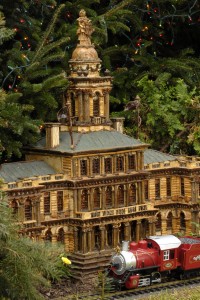 Ah, yes. The first month of a new job. So many exciting possibilities, but also so many questions! I just moved to New York City and just started at The New York Botanical Garden, so there certainly is a lot to learn. Since my first day, I’ve been happy to be thrown right into the mix, learning quickly about the Garden, the events, collections, location of the lunchroom—the general “first-week 101.”
Ah, yes. The first month of a new job. So many exciting possibilities, but also so many questions! I just moved to New York City and just started at The New York Botanical Garden, so there certainly is a lot to learn. Since my first day, I’ve been happy to be thrown right into the mix, learning quickly about the Garden, the events, collections, location of the lunchroom—the general “first-week 101.”
It’s an especially busy time here, preparing for the huge Holiday Train Show, which opens this weekend. It’s been interesting to see how much the staff and volunteers look forward to this event. Whenever someone mentions the Holiday Train Show, their voice changes a bit. When they find out that I’ve never been to the show, they immediately drop what they are doing to tell me about how beautiful the Conservatory looks when it’s all decorated and lit up or about their favorite landmark replica, like Yankee Stadium or the Brooklyn Bridge. Maybe they even mention that they secretly like The Little Engine That Could™ Puppet Show and that they are glad to have a 3-year-old nephew to use as an excuse to see it again this year. (Don’t worry; your secret is safe with me.)
Read More
Posted in Shop/Book Reviews on November 19 2009, by Plant Talk
Designer of NYBG’s Rose Garden a Real “Artist and Hero”
 John Suskewich is Book Manager for Shop in the Garden.
John Suskewich is Book Manager for Shop in the Garden.
 In Beatrix Farrand: Private Gardens, Public Landscapes, Judith Tankard avoids the pitfall of turning a historical figure into a waxwork and brings to life this pioneering woman who was one of the first important American landscape gardeners. As someone who designed an important feature of The New York Botanical Garden, the magnificent Peggy Rockefeller Rose Garden, Beatrix Farrand (1872–1959) is of particular interest to us here.
In Beatrix Farrand: Private Gardens, Public Landscapes, Judith Tankard avoids the pitfall of turning a historical figure into a waxwork and brings to life this pioneering woman who was one of the first important American landscape gardeners. As someone who designed an important feature of The New York Botanical Garden, the magnificent Peggy Rockefeller Rose Garden, Beatrix Farrand (1872–1959) is of particular interest to us here.
Hers is a great “little Old New York” story. Farrand’s aunt was Edith Wharton, she herself was one of Mrs. Astor’s “Four Hundred,” and Henry James was often a household guest, so she could have coasted. Instead, to a great talent Farrand added diligent study and travel, hard work, a facility for networking, and—for that time and place—a kind of courage. The commissions she attracted after 1900 included some of the most notable country places of that era: Crosswicks in Pennsylvania; the Fahnestock estate in Lenox, Massachusetts; Bellefield, the Newbold family property in Hyde Park, New York; and a slew of blue-blooded landscapes on Long Island.
The author’s chapter on Farrand’s assignment at The New York Botanical Garden is especially noteworthy. This involved creating an elegant design for a public rose garden out of a tricky site while developing a collection of roses that would have aesthetic and educational merit. The ups ands downs and ups of this rose garden reflect in a way NYBG’s own story, and of the difficulties that make landscape gardening such a complicated art, as time takes its toll. But time also tells, and in a volume that contains pages of marvelous photography, this garden is beautifully pictured, here and now, in its current state of grandeur.
Read More
Posted in People, Science on November 17 2009, by Plant Talk
Staffer Discovers Home, Resting Place of NYBG Founders on Staten Island
 |
Lisa Vargues is Curatorial Assistant of the Herbarium. |
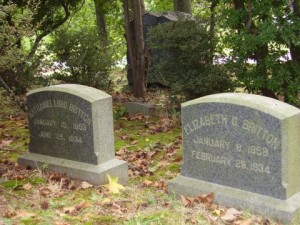 In honor of the 150th birthday this year of Nathaniel Lord Britton (1859–1934), who with his wife, Elizabeth Gertrude Britton (1858–1934), founded The New York Botanical Garden, I set out to retrace some of his footsteps. My pursuit provided further insight into his life and brought some fascinating places to light.
In honor of the 150th birthday this year of Nathaniel Lord Britton (1859–1934), who with his wife, Elizabeth Gertrude Britton (1858–1934), founded The New York Botanical Garden, I set out to retrace some of his footsteps. My pursuit provided further insight into his life and brought some fascinating places to light.
This spark of nostalgic curiosity came over me ever since I started working on the Flora Borinqueña Digital Herbarium and Library, a project that makes available online the unpublished manuscript of the popular flora of Puerto Rico— along with images of related specimens—that Britton was working on at the time of his death.
After more than 70 years, Britton’s final manuscript emerged from storage, and in a Rip van Winkle moment has been resurrected in a brand new era of computers and digitization. Ironically, Britton was resistant to installing electricity (“an unnecessary luxury”) in the Garden’s Museum building (now the Library building), and instead frugally worked by gaslight, according to The New York Botanical Garden: An Illustrated Chronicle of Plants and People.
While transcribing some of Britton’s last written words in the Flora Borinqueña, including his shaky handwritten marginal notes, I wondered where the Brittons’ final resting place is and whether there are any remnants of their life here in New York, outside of the Garden.
And so my search began.
Read More
Posted in Gardening Tips on November 16 2009, by Sonia Uyterhoeven
 |
Sonia Uyterhoeven is Gardener for Public Education. |
In the gardening world we all talk about “cultural care” and nod our heads knowingly: Growing requirements for vegetables include full sun, proper spacing, good drainage, and some kind of soil amendment, preferably organic material. We know the drill.
Being human, however, we often cut corners and hope for the best. Plants tend to be fairly accommodating—they grow in spite of everything we do to them—and often we walk away feeling like a success.
This year, however, the weather was so inhospitable that any corners cut turned into messy gaps in the garden.
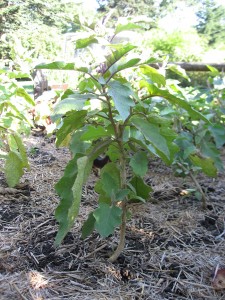 It was a miserable year for the “fruiting” vegetables such as peppers, eggplants, and tomatoes—at least in my garden. The warm-season crops sulked or came to a screeching standstill early in the season when June decided it was April and summer went on an extended leave of absence.
It was a miserable year for the “fruiting” vegetables such as peppers, eggplants, and tomatoes—at least in my garden. The warm-season crops sulked or came to a screeching standstill early in the season when June decided it was April and summer went on an extended leave of absence.
In one part of the garden we planted young transplants of peppers and eggplants in early June as is our common practice. The cool temperatures stunted their growth and these vegetables never entirely recovered (see photo at right). Why? They were planted in an area that is not blessed with full sun. With all the rain, the soil stayed cool and excessively moist for half the season.
Read More
Posted in Exhibitions, Kiku on November 13 2009, by Plant Talk
Final Year of Incredible Chrysanthemum and Japanese Garden Displays
Kiku in the Japanese Autumn Garden showcases more than 5,000 kiku (chrysanthemums) meticulously displayed in traditional Japanese styles. This last weekend—the exhibition is in its third and final year—step into the brilliant colors of a Japanese garden: kiku in full bloom, Japanese maples a deep red; and the Garden bustling with activities.
Don’t miss these highlights:
- The taiko Japanese drum is believed to be entertainment for the gods. You’ll be in good company as you enjoy a thrilling drumming presentation by Taiko Masala on Saturday and Sunday at 1 and 3 p.m.
- Japanese Autumn Adventures in the Everett Children’s Adventure Garden offers hands-on fun for the whole family. This weekend children can slip on a kimono and enjoy a tea ceremony.
- Take part in Home Gardening Center demonstrations of Japanese gardening techniques and docent-led tours of the Kiku exhibition.
Get Your Tickets |
Posted in Uncategorized on November 12 2009, by Plant Talk
Designer Takes Fresh Look at Its Matured Melding with Landscape
 |
Hugh Hardy of H3 Hardy Collaboration Architecture, was the principal designer of The New York Botanical Garden’s Leon Levy Visitor Center, which opened in 2004 and was included in the recently published book, 101 Cool Buildings: The Best of New York City Architecture 1999–2009. |
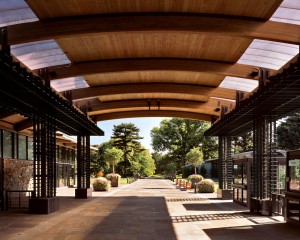 Appropriately enough, the original 19th-century entrance to The New York Botanical Garden was located by the railroad station. This was logical for the time; from there pedestrians and horse-drawn carriages could explore a landscape that stretched out before them to the south. Passing by an impressive axial view of the Library building, framed by a broad allée of tulip trees, this roadway connects directly with the axis of the new Visitor Center. This second access point is more centrally located, with a parking lot for cars and buses. It is focused on a broad walkway of bluestone paving blocks that leads to a small fountain and reflecting pool where open views of the surrounding landscape present an extraordinary collection of trees, offering a tantalizing promise of exploration.
Appropriately enough, the original 19th-century entrance to The New York Botanical Garden was located by the railroad station. This was logical for the time; from there pedestrians and horse-drawn carriages could explore a landscape that stretched out before them to the south. Passing by an impressive axial view of the Library building, framed by a broad allée of tulip trees, this roadway connects directly with the axis of the new Visitor Center. This second access point is more centrally located, with a parking lot for cars and buses. It is focused on a broad walkway of bluestone paving blocks that leads to a small fountain and reflecting pool where open views of the surrounding landscape present an extraordinary collection of trees, offering a tantalizing promise of exploration.
The intent of the new Visitor Center was to make a place where the Garden is revealed and discovered in all its seasonal variety, not to create a place embellished by buildings. First-time visitors can enter here, learn about the large extent of the Garden’s various collections and displays, rendezvous with each other, enjoy refreshments or investigate the gift shop. It is surprising to see how quickly a talented staff has made the bookstore and plant shop a destination in their own right.
Read More
Posted in Programs and Events on November 11 2009, by Plant Talk
Spend a Fall Day at Kiku, Greenmarket Finale, More; Veterans Get Discount
 |
Gayle Schmidt is Manager of Public Education. |
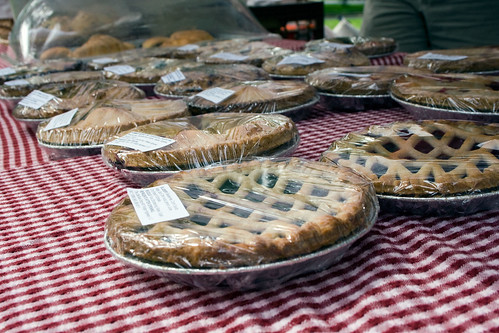 This week we say goodbye to our Greenmarket farmers and bakers for the year, as today and Saturday mark the last two markets for 2009. All summer and fall they have offered wonderful seasonal colors—from the bright green sprouts of asparagus and leaves of lettuces to sweet red cherries, purple radishes, yellow corn, and brilliant orange squashes and pumpkins.
This week we say goodbye to our Greenmarket farmers and bakers for the year, as today and Saturday mark the last two markets for 2009. All summer and fall they have offered wonderful seasonal colors—from the bright green sprouts of asparagus and leaves of lettuces to sweet red cherries, purple radishes, yellow corn, and brilliant orange squashes and pumpkins.
The autumn shades of the market table complement the beautiful showiness of the trees around the Garden and the spectacularly trained chrysanthemums on display in the Conservatory Courtyards in Kiku in the Japanese Autumn Garden.
Join us today as we present additional family activities at the Greenmarket and elsewhere in the Garden to mark the Veterans’ Day holiday. Grounds admission is free, though an All-Garden Pass is needed for the main exhibition and some programs. United States Veterans receive $5 off the All-Garden Pass purchased on-site with proof of military service.
As you stroll through the Garden, you will encounter some Japanese cultural programs to complement the beautiful Kiku in the Japanese Autumn Garden exhibition and Japanese Autumn Adventures. Try your hand at origami folding and saori hand-weaving on a traditional loom. Make a showy Japanese flower hat, and learn a few traditional dance steps that celebrate the flowers in the Children’s Adventure Garden.
Over at the Greenmarket at Library Allée, tap your toes to live music and taste some fresh apple cider that you can help press. We dare you to stick your hand in a giant pumpkin and grab a few seeds to count for the tally!
Our market always provides fresh fruits and vegetables, and we use this produce in whipping up easy recipes to help you decide what to bring home for dinner. Today I’ll be making some of my now famous butternut squash soup for you to taste. You can also learn what it takes to grow this great food at a discussion with one of our farmers, and you can even find out what to do with the peelings and scraps at Bronx Green-Up’s compost information table.
You won’t find a better way to spend a fall day!
Posted in Gardening Tips on November 9 2009, by Sonia Uyterhoeven
 |
Sonia Uyterhoeven is Gardener for Public Education. Join her each weekend through November 15 for home gardening demonstrations on a variety of topics in the Home Gardening Center. |
 With all of the crazy weather we’ve had this year, there has been a great deal of discussion of how weather and climate affects the plants we grow and cherish. This reminds me of the importance of microclimates in the garden and how it allows us to often successfully push the vegetative envelope.
With all of the crazy weather we’ve had this year, there has been a great deal of discussion of how weather and climate affects the plants we grow and cherish. This reminds me of the importance of microclimates in the garden and how it allows us to often successfully push the vegetative envelope.
Recently a woman came to a Home Gardening Demonstration that I was giving on herbs and herbal vinegars. We were looking at a collection of healthy rosemary I was growing in containers, a beautiful, blue upright cultivar called ‘Tuscan Blue’. We then wandered over to another section of the garden where a less robust specimen was struggling in a mixed border.
Rosemary, I explained, is borderline hardy in the New York area. We generally keep it in the ground over winter (it is a perennial herb) and then come back and check on it in the spring to see how it has fared. Usually, it is in such a sorry state that we end up removing it and replanting it with a specimen that has been protected in our greenhouses.
“Oh!” she exclaimed, “I had rosemary that flourished at my home for 5 or 6 years, and it never required any winter protection.” She then proceeded to explain that her rosemary had been situated in an area of her garden that was bordered by a cement walkway, which absorbed heat and warmed the bed. A few feet away, the white walls of the neighbor’s house reflected a fair amount of light into the border.
She had found a perfect microclimate for successfully overwintering her rosemary and other Mediterranean plants. The area provided shelter from damaging winter winds, good drainage, and just enough additional warmth to escort her rosemary through the chilly winter months.
This story reminded me of a friend’s New Jersey garden. The brick house’s laundry room heat vent opened up onto a section of the garden where he planted cannas (pictured), and he never had to lift them in the autumn. They flourished in their niche.
Read More

 The Grand Concourse, stretching over four-and-a-half miles in the Bronx, is one of New York City’s lesser known architectural delights. Now its political and social history is the subject of a new book, Boulevard of Dreams: Heady Times, Heartbreak, and Hope along the Grand Concourse in the Bronx, by New York Times City Desk editor Constance Rosenblum.
The Grand Concourse, stretching over four-and-a-half miles in the Bronx, is one of New York City’s lesser known architectural delights. Now its political and social history is the subject of a new book, Boulevard of Dreams: Heady Times, Heartbreak, and Hope along the Grand Concourse in the Bronx, by New York Times City Desk editor Constance Rosenblum.













